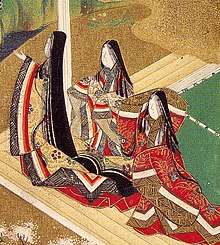Kyahan
Kyahan (脚絆(きゃはん)) are cloth leggings worn by the samurai class and their retainers in feudal Japan.[1] In Japanese the word is also used for western soldier's gaiters.
Description
Kyahan were worn as padding underneath the samurai greaves (suneate). Some types of kyahan could be covered with mail armour (kusari kyahan or kyahan suneate), these were worn by foot soldiers ashigaru or by samurai as protection.[2] Kyahan were worn by ordinary travelers as protection from cold, insects and underbrush.[3] Kyahan are often made of linen, but other materials such as cotton can be employed. Kyahan components depend on the season. When tying kyahan, the inner cords are shorter than the outer ones; it is also advisable that the cords are tied on the inner side of the legs instead of on the front or outer area. This helps prevent discomfort when the stiff greaves are placed over the kyahan.
References
- Bottomley, Ian (October 23, 1996). "Arms and Armor of the Samurai: The History of Weaponry in Ancient Japan". Crescent Books – via Google Books.
- Ratti, Oscar; A, Westbrook (October 23, 1991). "Secrets of the Samurai; A Survey of the Martial Arts of Feudal Japan". C. E. Tuttle – via Google Books.
- Murray (Firm), John; Chamberlain, Basil Hall; Mason, W. B. (October 23, 1894). "A Handbook for Travellers in Japan". J. Murray – via Google Books.
Sources
- Turnbull, Stephen (1998). The Samurai Sourcebook. London: Arms & Armour Press. ISBN 1-85409-371-1 [reprinted by Cassell & Co., London, 2000. ISBN 1-85409-523-4 ]
